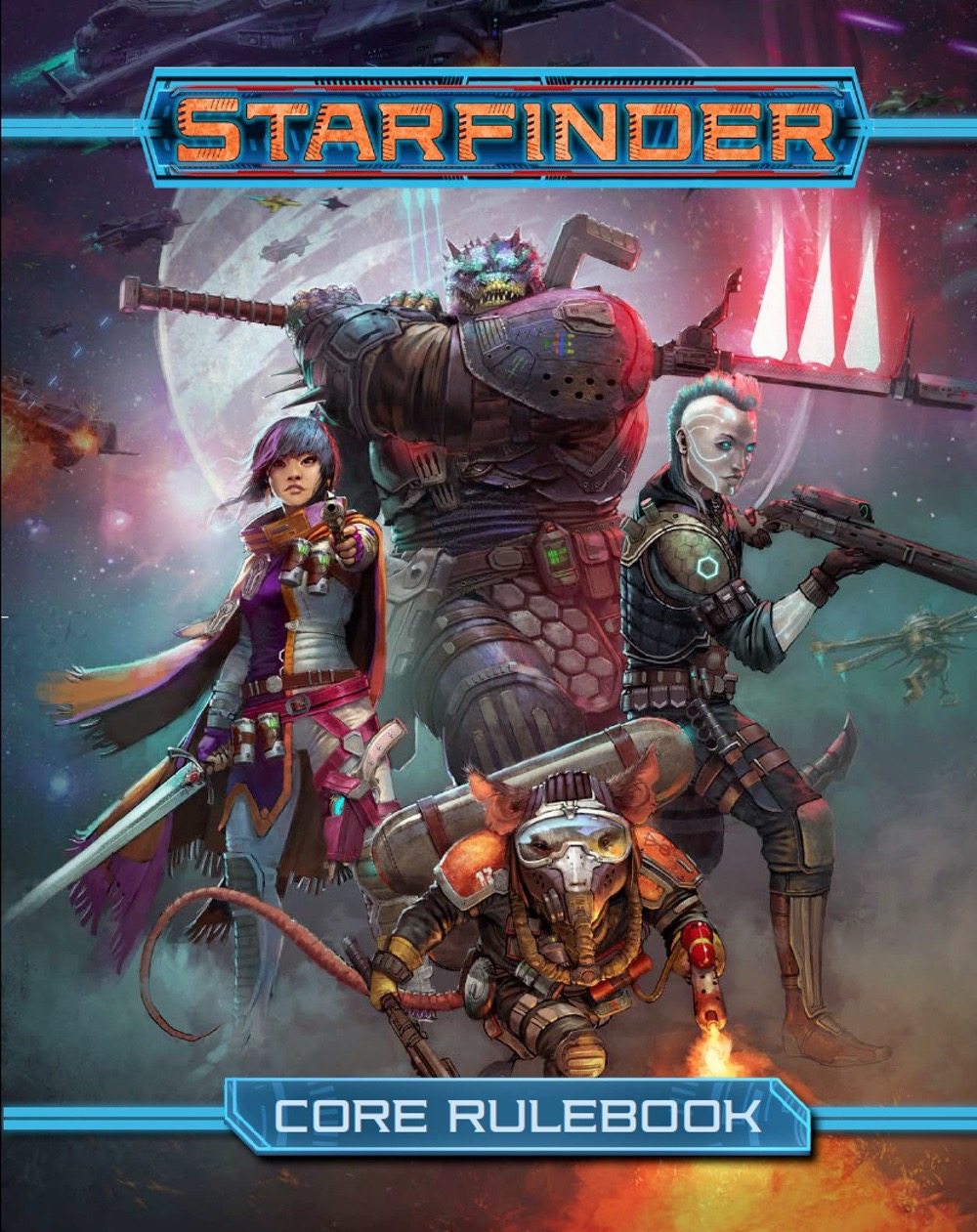
The Starfinder Roleplaying Game hit the shelves at GenCon 50 then disappeared faster than Golarion during The Gap!
Ok, sorry… but following the trend set by Pathfinder’s release a decade ago, all the Starfinder Core Rulebooks at GenCon sold out on the first day! Fear not though, to start exploring this engaging science-fantasy world, you can still pick up a copy on Paizo’s online store in hardback ($59.99) or PDF form ($9.99!), Amazon (currently $48), or ask at your FLGS. You can also subscribe to all the Starfinder material on the Paizo site. The subscription gets you all released physical materials at the cover price, but the PDFs are included!
Over the past couple of days I read through the entirety of the Starfinder Core Rulebook in PDF form. I read with particular interest for the differences from Pathfinder, but those differences will end up in another post. Here are my take-aways.
At a Glance: What Is ‘Starfinder?’
The Starfinder Roleplaying Game is a science-fantasy themed table-top roleplaying game. Envision the world of dragons, demons, sword-wielding heros, and magic-using wizards, but they’ve advanced into a space faring society with lasers, AI computers, and faster-than-light space travel… imagine that and you have a vision of Starfinder. More specifically, Starfinder takes place in the same universe as Paizo’s Pathfinder fantasy roleplaying game, but in the distant future.
Golarion, the planet on which the Pathfinder campaign setting takes place, mysteriously disappeared 300 years prior to the current Starfinder setting. There is a collective gap in the records and memories of all creatures within the universe. No one knows where Golarion is or why it disappeared and in its place is Absalom Station, the hub of the Starfinder campaign setting. Thematically, this gives Starfinder an all encompassing mystery, something the characters can search for answers to, or ignore for other pursuits. Practically, this separates the two game systems such that what your heroes do in Pathfinder still matters and is not nullified by Starfinder lore. Your Starfinder characters don’t know whether the Runelords rose up or were defeated. All of your Golarion adventuring has no obvious bearing on your science-fantasy character’s lives on Absalom Station. You can play both simultaneously.
Mechanically, Starfinder is a role-playing game where you create characters that play various thematic roles, selecting ability scores, and special abilities. As the characters gain experience, they gain skills and power by leveling up. The primary game mechanic is rolling a 20-sided dice (d20) and applying various modifiers representing a character’s skill and comparing the results to a number representing the difficulty of achieving an objective. A game master guides these player through a story.
The Core Rulebook
Throw in some paper, pencils and dice (d20, d12, d10, d8, d6, d4) and The Starfinder Core Rulebook and you have everything you need to play the game. You may want some monsters, and you can choose from the 15-page First Contact bestiary released for Free RPG day, or wait until October for the full-blown Alien Archive, but you can start right now. As I’ll discuss later, if you have a Pathfinder Bestiary, you’re also set, as one of Paizo’s design philosophies was to make all the big-bads in the bestiaries compatible with minimal conversion.
The Starfinder Core Rulebook is a massive 520+ page book that contains everything you need to know to construct and level unique and interesting characters, with information on playable races, character themes, and classes. There are entire chapters on the various skills, feats, equipment, magic, and spells available in the game, character combat, starship building and combat, setting information and more.
The Core Rulebook is stunning.
The layout, graphics, and art are all beautiful, just as we expect from a Paizo product. The layout is clear and easy to use and is rife with science-fantasy themed graphics and stellar art. Paizo has used this design to set Starfinder apart from the rest of their products. Where Pathfinder books have an old manuscript feel with warm, earth tones, and swooping graphics, Starfinder stands out in your collection with hard edges and cool tones.
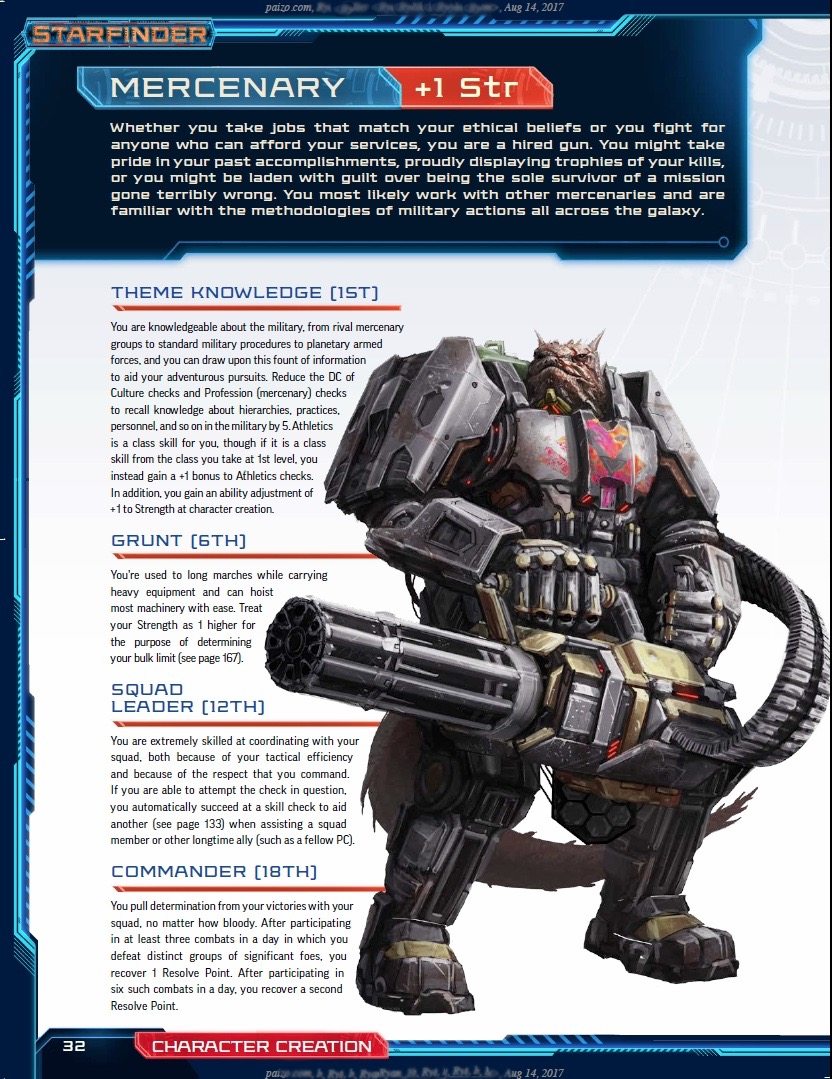
Paizo has always provided access to both the exquisite printed version of a book, as well as a PDF version. I love having the PDF for travel to cons, for searching, or for obtaining graphics, such as for this post. The one missed opportunity here, though, is that I want to start seeing game rules released as true eBooks. Starting with a new line, this would have been a great time to dive in.
With an eBook we could get a responsive design that changes its layout based off the size of the screen available just like a web page does. I know this is likely a cost issue, as static layout is way less time consuming than making a dynamic layout look as superb as the Starfinder Core Rulebook across mediums. In any case, we do have access to PDFs. Further, just like the online Pathfinder Reference Document I’m sure we’ll see an online Starfinder Reference Doc…the best way to look up rules on your phone during the game!
Does ‘Starfinder’ Use the Same Ruleset as ‘Pathfinder?’
For Starfinder, they took all that is awesome about Pathfinder–deep and engaging setting, endless character creation options–and left out some unnecessary complexities. In short, though, if you know how to play Pathfinder, you know how to play Starfinder.
If you’ve never played Pathfinder, then the differences won’t matter to you. All you need to know is that it’s a significantly simpler game than Pathfinder, while leaving you all the richness of the system. In a later post I’ll detail some of the big differences between the two systems.
Character Creation
One of my favorite aspects of Pathfinder is character creation. Don’t tell anyone, but I make characters for fun. Some call it the character creation mini-game. Hero Lab, soon to support Starfinder, by Lone Wolf Development, makes it a breeze. Starfinder is no different, also focusing on interesting and flexible character builds. There are a wealth of options in terms of the race you can play, and what role you choose to fill. Offering seven races, seven classes, and ten themes that act as a “core aspect” of your character’s backstory, these choices alone provide a few-hundred different options. This even before making the fine tuning choices of ability scores, skills, and feats.
Seven of the thirteen chapters focus directly on your characters, there are chapters on Character Creations, Races, Classes, Skills, Feats, Equipment, and Magic and Spells.
Races
While the old races–elves, dwarves and the like–still exist and there are rules for play, the core Starfinder races are the ever-present humans, androids, ysoki (rat folk), lashunta, kasatha (four-armed humanoids that showed up in the star system on a multi-generational colonization ship), vesk (reptiles that only recently ended warring with the other races), and shirren (insectile creatures separated from a hive-mind).

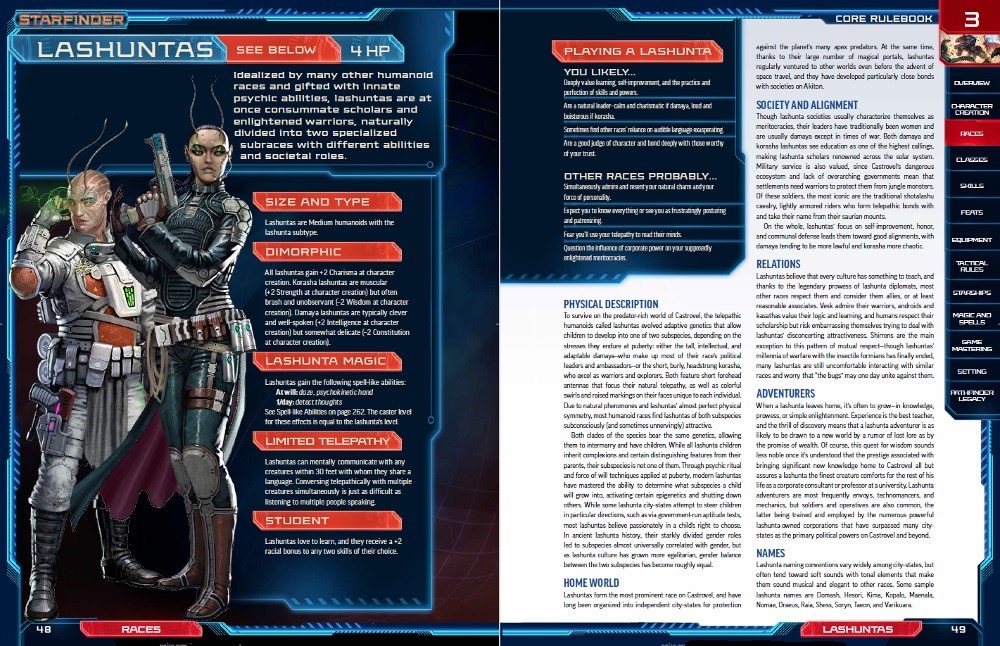
Each race has a dedicated two-page spread that details various racial benefits and draw-backs. More importantly, each offers intriguing background such as the backstory for the Shirren. Originally part of the The Swarm, a hive-mind race that traveled the stars consuming all in its path, the Shirren, through a mutation, have now gained a sense of self, and thrive on individualism. Or the reptilian Vesk, formerly in bitter conflict with the other races, reaching a truce to collectively fight off The Swarm. While Vesk will be adventuring side-by-side with humans and the rest, the political situation with the Vesk is tenuous at best. Just like all Paizo content, the race descriptions alone are full of playable material!
While these are the core races, most any creature introduced in the Alien Archives will include information on how to make them playable characters as well, like this example from First Contact (a free PDF of aliens). If you want to play a space goblin, Paizo’s got your back.

Classes
The character’s role, or class, is perhaps the most defining element of all. Whether you want to be a spell-casting Mystic or Technomancer, heavy-hitting Soldier, hardware-hacking Mechanic, or sneaky Operative, Starfinder has a wealth of options for you. Just like in Pathfinder you can also easily multi-class, taking some levels of Mechanic say, and enhancing your skills by throwing in some Technomancer.
Magic was prevalent and powerful in Pathfinder, while technology was minimal. It makes sense that in a world where needs such as distant travel, mass destruction in war, communication, and much more are satisfied by magic, that there’s little impetus for technology to advance very quickly. Even mundane tasks such as cleaning are satisfied by a cantrip, prestidigitation! In Starfinder, however, technology has finally caught up and is at the forefront and magic has stepped back in prevalence. For this reason, there are less magic-using classes, and the lines between technology and magic are often blurred.
I could spend a whole post covering all the awesome in these classes, but here’s a snippet from the Core Rulebook to wet your appetite.
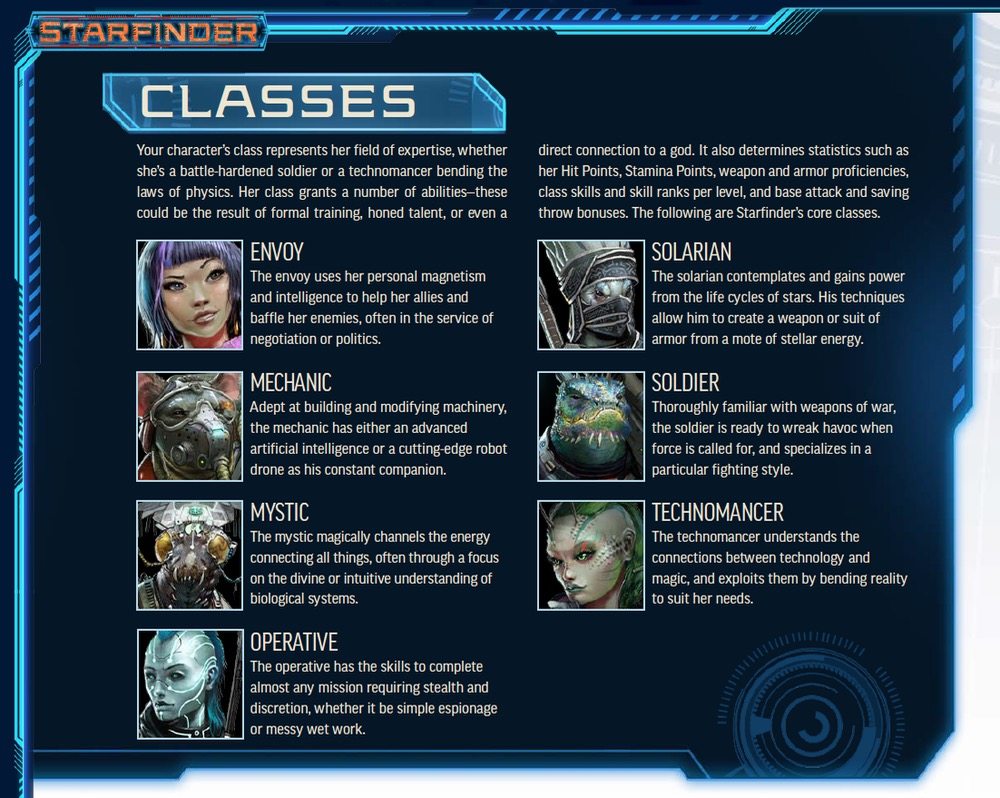
Themes
The last major choice is theme. A theme is a focus for your character. While you may be a stealthy operative on the ground, you may also be an Ace Pilot. Maybe you’re a soldier, protecting your fellow explorers by taking down foes big and small, but you also are an Icon, advancing in the ranks in Starfinder Gladiator spectacles. Perhaps you’re the same soldier, but instead you’re a Scholar focusing on the academic of the martial arts. It’s just another way to distinguish your character and meet the character concept you’re setting out to achieve.

A Quick Concept
Much like Wayne Reynolds created most of the defining Pathfinder art, Remko Troost is the defining artist for Starfinder. Among other art he created, the cover illustration, as well as the artwork for each iconic, characters generated to showcase a race and class, and are depicted throughout Starfinder materials. His astounding art alone is enough to draw me to Starfinder. Remko was at PaizoCon 2017 so I commissioned some artwork from him. I did not yet have a character concept so I just had him draw me, as a hacker, very loosely what I am… and voila, my first character.
I know it’s bad form to tell people about your character, but I’m going to anyway. In real life I’m a technology teacher, and most would say human, so my first character (that I’ll use for Starfinder Society Organized Play) is a 48 year-old (ahem) human, former-InfoSec teacher that felt the need to join the Starfinder Society after their catastrophic loss of agents. Ryan is a Mechanic with a built-in AI, an exocortex, enhancing his abilities (instead of the drone a mechanic can instead choose). For theme, instead of Scholar which doesn’t quite fit, he’s going to go with Icon. He records his exploits Periscope-style and uploads or livestreams them to the infosphere, Starfinder’s equivalent of the Internet. I hope I don’t die.
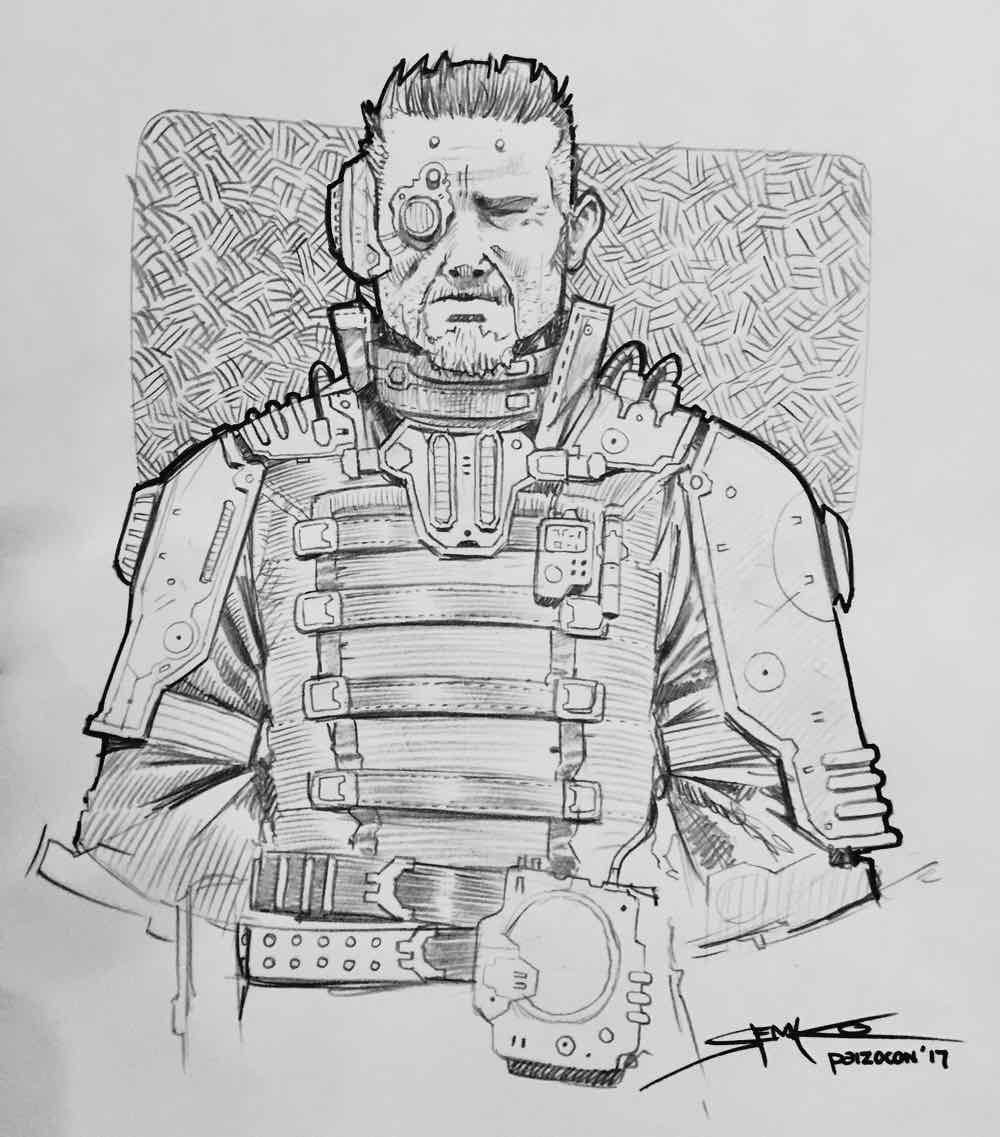
There are so many more concepts I want to dive into, the four-armed Kasantha Technomancer Outlaw, or the elegant Lashunta Operative Bounty hunter. So much to play, so few gaming sessions!
The Fine Points
Once you know the main parts of your character–race, class, and theme– you finalize some details. Like Pathfinder, each character has Strength, Dexterity, Constitution, Intelligence, Wisdom, and Charisma. Race and theme affect these abilities a little, and you can adjust the rest. You can then pick various skills to be proficient in, select a feat, representing a special ability, and purchase equipment. Last, you find Remko Troost and commission him to draw your character and you’re all set!
Equipment
Characters can finally carry all their wealth with them as they use digital currency in the form of credits in Starfinder. What can they buy though? First off, equipment in Starfinder has a level. A character should be using equipment that is close to their current level. You shouldn’t see a first level character running around with the level 18 Banshee Sonic Rifle, or a level 17 Molecular Rift Longsword. This helps the game master to quickly outfit NPCs and monsters, or hand out loot, and keeps everything balanced in terms of power.
There are pages-and-pages of melee and ranged weapons. Rifles and pistols can be cryo, flame, laser, plasma, or projectile based with each category ranging from low to high level. In the Starmart, a character might see the 425 credit Azimuth Laser Rifle which inflicts 1d8 points of fire damage and 1d6 burn on a crit, while salivating over the 722,000 credit Zenith Laser Rifle, putting out 11d6 of fire damage with 5d6 of burn on a crit. Now that’s a satisfying handful of dice to roll!
Ok, but what are we looking at for melee weapons? If your Pathfinder character shows up at the Starmart, he might recognize the good ol’ level one longsword that’s available for 375 credits (hope that gold converts!), and it puts out 1d8 of damage, but what’s that Dimensional Slice Longsword do? And is 727,000 credits a lot? The kid behind the counter might say, “Dimensional slice blades have only a narrow visible blade area, surrounded by a solid aura; these are the sharpest and most dangerous blades on the market. You from around here?” Looking for the light saber feel? You might want to check out the plasma swords.
Some weapons are a fusion of technology and magic. There are many fusions you can add to a weapon like entangling, flaming, frost, holy, illuminating… the list is long. Oooh, there’s the vorpal fusion, snicker snack!

It’s not just about combat, though. There are pages of armor, most of which double as a spacesuit! Characters can add augmentation, like cybernetics, including extra limbs, data jacks, dermal plating, climbing suckers, and a dragon gland… gee, I wonder what that does! Then there’s biotech to add a gill sheath, or chameleon skin to name a couple. There are five pages on computers and how to secure them, comm units, explosives, medical gear, spy drones, x-ray visor (ordered from the back of a comic I’m sure.), holo-skins, and spell jammers. One of the ways to bring back a fallen character is with a regeneration table– one time use for 45,000 credits. There are serums, that act like Pathfinder potions, and there are of course many magic items.
One thing missing is mechs. This is assuredly coming, likely as part of a future Adventure Path, but at already over 500 pages the Core Rulebook had to exclude some things! The equipment list will grow quickly as more material is released.

Starfinder Has Starships!
I am as excited for creating starships as I am for cranking out some characters! It’s clear that Paizo understands the importance of starships in a science fiction game as they assume that each adventuring party will have a starship from day one. Think Serenity, the Millennium Falcon, the Rocinante, or even the Nostromo from Alien. Fortunately ships are removed from the economy of the game and simply level with the players as if it’s another character. Due to the importance of starships, the Starfinder design team didn’t want to make us wait until our characters hit high enough levels to get a ship. They wanted to make them be core to the game starting with lowly first level characters… a decision I whole-heartedly agree with… because, spaceships!
Carrying the ships-as-a-character concept further, each ship can even have its own personality.
A computer system functions in many ways as a ship’s brain. Most computers aboard starships have at least a rudimentary artificial personality, and while they can’t fully perform the duties of a crew member, they can assist crew members in various tasks. However, many spacefarers claim that over time, a starship’s computers can develop temperaments and personality quirks that set them apart from identical computers in other ships.
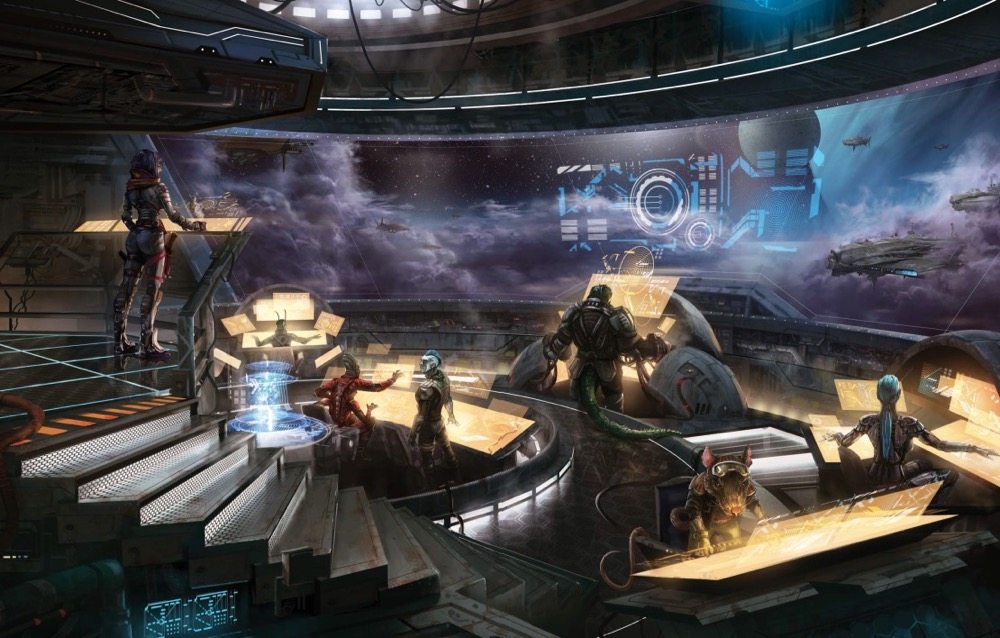
In and out of combat, each character has a role on the ship, and they can switch up which roles they perform. Characters can fill the role of captain, pilot, gunner, engineer, and science officer. You can only have one captain, one pilot, but a ship can have multiple of the last three positions. The ship’s computer can also fill in for these roles, but with less skill than the typical character.
Paizo satisfies all the tropes. You can envision Captain Kirk taunting the enemy while bolstering his crew, Wash skillfully making daring maneuvers with the ship while Kaylee jerry-rigs the engine, Luke taking out foes with carefully planned shots, and Spock scanning the enemy for vulnerabilities or even uploading code to shut down Kahn’s shields.
Starships can use conventional engines for travel within the solar system. Many ships, though, employ Drift Engines to enter a parallel plane for faster-than-light (FTL) travel. I covered this in more depth in an earlier post on GeekDad.com, The Drift: GeekDad Exclusive Look at ‘Starfinder.’ Watch Your Mouth, Kid, or You’ll Find Yourself Floating Home! This unique solution to FTL travel introduces Triune, a new god of dubious motivation, and an interesting mechanic where pieces of other planes of existence get torn off and sucked into the Drift anytime a Drift engine is utilized. Nothing like running into some irate demons as you take your short hop through space-time!
Starships range in size from tiny, 20-60ft, in length to Colossal, over 15,000 ft in length. The typical adventuring party is going to likely begin with a light freighter or explorer; ships in the small to medium range, 60-300 ft in length. Both are manageable by one crew member but able to take advantage of up to six crew.
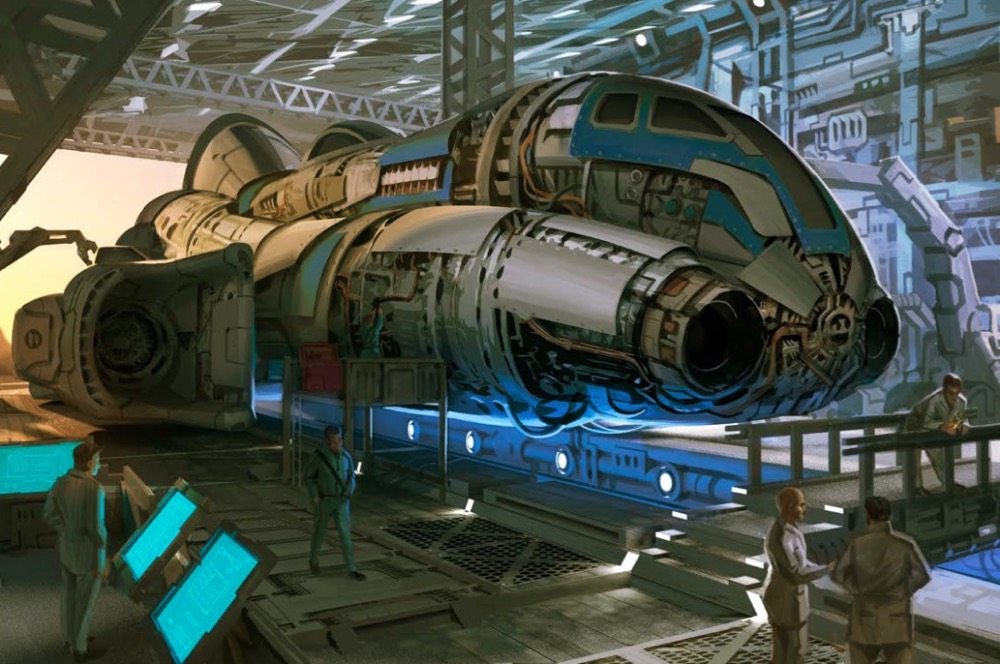
The first step in building a ship is picking its Basic Frame. This determines its size, maneuverability, base hit points, weapon options, crew size, and expansion options. After choosing a basic frame, the players then have to make choices concerning power core, thrusters, weapons, armor, computer, defensive counter-measures, drift engine, shields, and other options. Each ship has a number of bays that can be configured in various ways: an arcane laboratory, cargo hold, escape pods, guest quarters, hangar (on gargantuan or larger ships), life boats, extra power core, recreation suite (for playing Pathfinder!), science lab, sealed environment chamber, shuttle bay, smuggler compartment (shhh), synthesis bay, or tech workshop. A party has a certain number of Starship Build Points based off of their average party level (APL) and each of these choices costs some of these points.
As characters level, so does their ship. They can choose to add components to their current ship or essentially trade it out for one of a different basic frame. All of this is separate from character wealth, utilizing Starship Build Points. Again, this is to get starships into the hands of the players from the get-go.

Combat takes place on a hex map and consists of rounds (that don’t correlate to a specific amount of time) that are subdivide into three phases.
- Engineering: Engineers (if present) repair or boost their systems.
- Helm:
- Pilots move their ships (lowest skilled first) and can attempt dangerous maneuvers to push their ships beyond normal limits.
- Science officers can use the ship systems to scan vessels or target foes.
- Gunnery: Gunners fire their weapons with all results being determined simultaneously.
Damage in combat gets applied first to shields, and once depleted, then to the starship’s Hull Points. When a ship hits zero Hull Points it is disabled and continues floating through space on its current heading. At least the party won’t be TPK’d in a fiery but silent explosion in space! If a gunner scores a critical hit (natural 20) or the Hull Damage done exceeds the ships Critical Threshold, the ship’s systems start to get affected; life support, sensors, weapons, engines, and power core can all take escalating critical damage effects. The characters can then try to mitigate these issues.
Characters each have options for what they can do each round, it’s not just moving and shooting. As an example, captains can buff allies or de-buff foes as well as, with an extremely hard to achieve die roll, grant extra actions to crew members. Engineers can divert power to boost systems, keep critically damage systems operational, and fix damaged systems… “I’m giving it all she’s got, captain!” The other starship roles have many options as well. It will never be a dull moment on the ship!
Spaceship combat appears to be simple and engaging while allowing for every party member to have an influential role. One of my core needs as a player is to have options every time it’s my turn. I want to have to pick between many options of ambiguous merit, fret over spending limited resources, and develop a unique story… Starfinder seems to offer this in starship combat just like it offers with character combat.

While I’m looking forward to starship combat, I’m much more excited to just contribute to the creation of the starship’s story, creating an interesting ship and taking it on wild adventures, determining the purpose of the ship, the layout, name, configuration. Did we choose the holo-deck (er… holographic amusement chamber, HAC), or extra power, and how will that influence our exploration.
If you’re interested in Starfinder Society Organized Play, you may be wondering how a group of strangers will be able to sit down at a gaming table and have a ship. My understanding is that there will be base models provided by the Society to each group of characters. Various character boons from prior sessions will allow you to modify or boost the ship you choose. Essentially the society has as fleet of ships that members can utilize for missions.
The Setting
Like all of Paizo’s setting material, the chapter on the Starfinder campaign setting is just rife with boundless gaming hooks. As I read it my mind kept running off on tangents thinking of the cool campaigns that could be written around a couple lines of text in the chapter.
Starfinder is, at its core, a game about exploration: discovering new worlds, meeting previously unknown cultures, and expanding the borders of the known.
The chapter discusses how the ability to travel at FTL speeds through the Drift came to be as three AI’s coalesced into one, Triune, and ascended to godhood; how planets in the Golarion system formed the Pact Worlds to combat the reptilian vesk, and how the vesk ultimately joined forces with the Pact Worlds to turn back The Swarm. There’s a timeline provided covering the 317 years since the Gap ended. The Gap is the span of time where there is no record or memory, when Golarion from the Pathfinder campaign setting disappeared. No obvious clues are provided as to why the universe had a collective memory lapse.
There are a couple of pages with superb art and excellent flavor text for each of the major planets, as well as Absalom station and a generation starship, Idari, left orbiting the sun.

I look forward to learning more about the sports of brutaris and star lance, and hope to maybe do some ship racing. I wonder if Syrinscape will treat us to some Akitonian shock beats and Absalom eyebite rock.
Whether your characters explore the bubble-cities on the sun, delve into the deteriorating spires of the First Ones on Aballon, or get wrapped up in the intrigue on Absalom station, there’s boundless opportunities within the star system, and voyaging beyond using Drift technology.
The first adventure path, Dead Suns, has the characters start on Absalom station;
When a brutal gang war breaks out on a docking bay in Absalom Station, the player characters are recruited by the Starfinder Society to investigate the unexpected bloodshed. Delving into the station’s seedy Spike neighborhoods, the heroes confront the gangs and discover that both were paid to start the riot and that the true conflict is between two rival mining companies battling over a new arrival in orbit around the station: a mysteriously deserted ship and the strange asteroid it recovered from the Drift. To head off further violence, the heroes are asked to investigate the ship and discover what happened to its crew, as well as the nature of the asteroid it tows. But what the players find there will set in motion events that could threaten the entirety of the Pact Worlds and change the face of the galaxy forever…
Can You Use ‘Pathfinder’ Content in ‘Starfinder?’
Tl;dr, yes! With just a couple of minutes work, you can easily convert a Pathfinder monster; boost hit points, use attacks as written or do a quick conversion to Starfinder‘s non-iterative attack method, Spells can be used as written and using Starfinder spells when a match exists, feats can be used as written, and there’s some remapping of skills. Last, you might want to change weapons to match the science-fantasy setting using some Starfinder weapons. This is easy, as you just grab a weapon with the same level as the monster’s CR. Last, it can be easier than all that. Simply grab a monster, use it as written, converting AC on the fly. In lieu of armor class, touch AC and, flatfooted AC, Starfinder uses Kinetic Armor class (KAC) and Energy Armor Class (EAC). To convert, KAC = AC and EAC = AC -1. Voila!
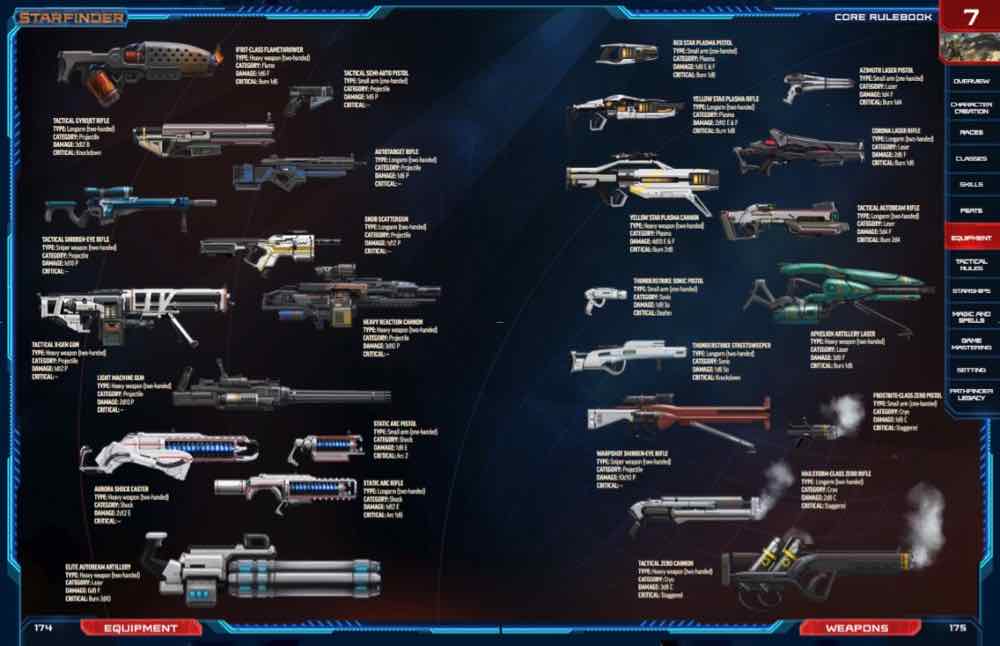
One of the core objectives of the Starfinder design team was to make monsters easy to integrate into the Starfinder ruleset. They’ve achieved this goal, leaving us six Pathfinder bestiaries of awesome to include in our games! So, while we wait for Alien Archive releasing in October, we’ve got some beasties to play with. Of course the Dead Suns Adventure Path includes what’s needed for the adventure.
Characters are not as easy to convert as monsters, but it does not appear too difficult. Due to differing action-economy between the systems, where a swift action cannot be performed with a full action, some swift-action-dependent classes like the magus or the war priest will take a hit in their capabilities. Basically, character conversion would just take some time sitting with the game master, and the guidelines in the Core Rulebook, to hash it all out. So, yes, if through some fluke of magic or technology, your Pathfinder characters should suddenly find themselves… in spaaaaace! they’ll be set. It would not be too difficult to send some Starfinder characters back to Golarion either. Maybe we should try whipping that ship around the sun… that’s how Tiberius did it right?
The Verdict
Paizo was able to simplify the Pathfinder system, while keeping what I love most about Pathfinder– a wealth of character options–and providing us with a rich universe full of intrigue and lore to play in. The character options leave my mind swirling with ideas, and I’m excited to start building a ship. In short, I’m ready to start playing!
It’s not just me that is excited about Starfinder. The Glass Cannon Podcast announced at GenCon that their next live-play podcast will be a Starfinder game running through the Dead Suns Adventure Path once their Patreon hits $10,000 per month… yes, you read that right, this is a podcast featuring people playing a roleplaying game and it’s so awesome that over a thousand subscribers are paying nearly $10,000 per month to support the show!
Even though Paizo brought more Starfinder Core Rulebooks to GenCon than any other product ever, they sold out in just five and a half hours! This is a testament to the quality material Paizo produces, and to the awesome community they’ve created.
Holy cow, #gencon50! We brought more Starfinder CRB than any product ever, and you bought it *all* the first day! 😮 pic.twitter.com/lJIYMvKuTI
— James L. Sutter (DARKHEARTS out now!) (@jameslsutter) August 17, 2017
I’ve already got two active Pathfinder campaigns going that I do not want to delay, so to immediately start playing Starfinder I intend to game master every new Starfinder Society Organized Play scenario by play-by-post. I’m also going to run a weekly one-hour session (Glass Cannon Podcast style) with my kids. I also look forward to sessions at the already awesome, PaizoCon. 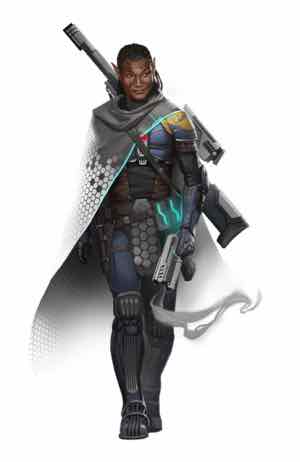
Still uncertain? You can get the Starfinder Core Rulebook PDF for just $9.99 on the Paizo site. This is everything you need to play the game. Want a ready-made adventure? Add in the first chapter of the Dead Suns Adventure Path, Incident at Absalom Station PDF for $15.99, or if you want a bite-size one-off module to try out, get one of the Starfinder Society scenarios for just $4.99.
If you’re ready to jump in head-first now, everything is available in the Starfinder section of the Paizo site.
In addition to the Paizo materials, HeroLab character management software will be offering a Starfinder module (which will allow you to build ships as well!), and Syrinscape is already offering Starfinder sound sets to add excellent sound effects and mood-inducing music to your game sessions. Last, Ninja Division will be selling painted and unpainted plastic Starfinder miniatures. The support for this game from Paizo and third parties is enormous.
Paizo has another hit on their hands. I look forward to following the Starfinder story, and adding to it as a game master and a player.
Good work Paizo!
Disclosure: Paizo provided the Starfinder Core Rulebook PDF for review.
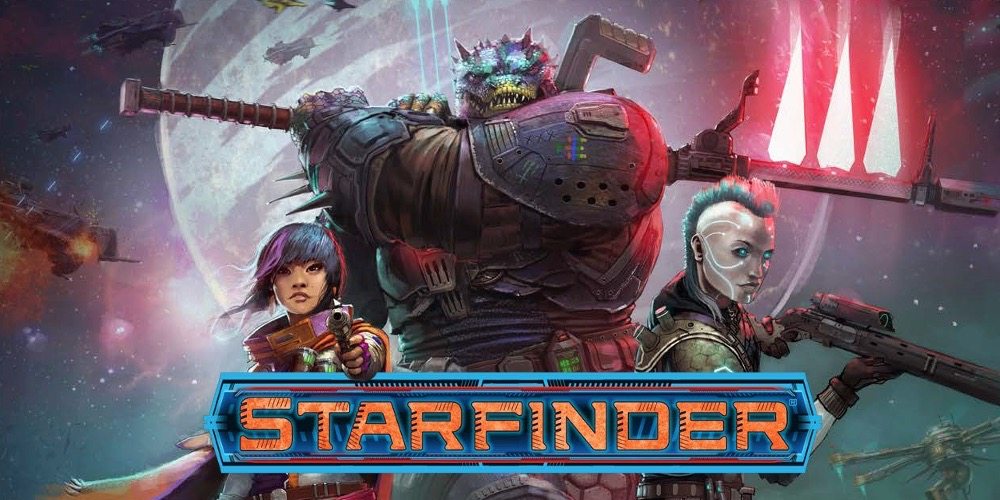



One Word: AWESOME!
I’m looking forward to some good play time!
“In a later post I’ll detail some of the big differences between the two systems.” As I’m not a fan of overly complex systems (aka, Pathfinder) I’m EXTREMELY interested in hearing about this. I bought Starfinder mostly because Paizo does an amazing job with setting and artwork.
But now I’m really intrigued to find out more about playing. Hopefully we won’t have to wait too long for that second article!
The post is pretty close to being done. It was actually part of this post, but due to length, and potential target audience, I pulled it. So, soon!
On The Drift Starfinder related podcast they quoted Eric Mona, Publisher at Paizo, as saying that if Pathfinder was a 10 in complexity, Starfinder is a 6.
I’ll list out the differences…
Just saw the new article–thank you Ryan for doing a yeoman’s job of covering the differences!yeo
Cool, you’re welcome!
As a pure D&D guy looking for a Sci-Fi RPG, we tried a demo at Gen Con.
We were not super impressed.
We didn’t get an explanation of all the character skills, stats, and rules.
Questions were just no you can’t and not why about skills/ abilities to use in combat.
We eventually just gave up and rolled D20’s and used basic attacks instead of trying anything fun, you know like skills and such.
It was kind of an unfriendly demo for us.
We were the only non-Pathfinder people in our group and kind of felt treated as such. not knowing the intricacies of the Pathfinder game.
The character sheet looked really bloated. The combat stuff was more modifier heavy than I expected and felt pretty rule bloated as well.
I know the game will be stooped popular and the opinions of two dudes matter not. Still we were not impressed with Starfinder with the tiny experience we had running it. Maybe a different demo might change our minds?
Not that the game might not be for you, but this sounds a little more like a GM issue… GMs should be saying more “Yes, but…” than “No.” It’s a new system, maybe he/she was not very familiar, maybe tired, etc, etc. But, regardless of the system D&D 4.0, D&D 5e, Pathfinder, Starfinder, Shadow Run, you should be walking away having had a great time given a reasonable group of people and GM.
Not getting “an explanation of all the character skills, stats, and rules.” is certainly a problem. Tough to play if you aren’t informed how to… sounds like the GM was assuming Pathfinder knowledge. It’s an easy switch if you know Pathfinder.
What version of D&D are you mainly, 5e? I have not played 5e, but read most of the rules. My guess is that Starfinder lands somewhere between 5e and Pathfinder in terms of rules complexity.
I’d love to hear what specific skills/rules you were trying to do to get more of a feel for your issues.
I have been a pure 1st,2nd, 4th and 5th D&D guy. I have had one demo of Pathfinder, but that was year 1 of that game. I remember really nothing of it.
Yeah we felt like outcasts in our game since we are not Pathfinder players and members of the “society.”
We never knew what could and couldn’t be done in a combat round. We just gave up and rolled a D20 to make an attack or cast with a lazer gun/ spell.
I had no idea when or how to pull off a feat. We had no idea what RP were, when to use them. A feat tied to an RP ability? How to use that? What is Su about?
5ht edition D&D 1st level guys are much leaner than Starfinder characters. The sheet is pretty intimidating with so much stuff there that you have no real idea about.
I get they wanted people to play as fast to get as many as they could through. However, 5 minutes about basic rules would have been swell for me and the 7 other people who have no clue about the Pathfinder/Starfinder system (well outside of the typical stats and D20 system).
Maybe a real demo for complete noobs would make for a better experience?
Oh, definitely… you needed a better experience, and better explanations. Resolve points are pretty integral to Hit Points/Stamina points and healing stamina/not dying, etc. Also key to some feats. Su is a supernatural ability. What really matters with the feat and the Su is they will say “as an attack” or “as a full action”, or “as a reaction”, etc… that lets you know when you can use it.
You needed a good explanation of action economy/what you can do in a round (I’ll discuss more in my next post when I compare to Pathfinder)
For example, each round you can either perform a
1. swift action (skllls/feats etc will say it’s a swift action) and a move action, and a standard action
or
2. 1 full action
and one reaction (for like an AOO if somebody leaves your threatened square)
again the feats and such explain what they are and when they can be used.
But you needed these things (and more) explained at the table. Society can be pretty harried with 2-4 4 hour slots a day, hundreds of people, etc. And if your fellow players were not welcoming, that’d be hard.
I love having “more” feats, skills, options, etc with my Pathfinder/Starfinder characters, but just getting thrown into it without explanation or time to read the rules, etc would certainly not be a great experience.
I hope you get another chance to try it with a more forgiving table sometime!
Ooh… another way to get a great feel for the system is to listen to The Glass Cannon Podcast. They currently have a weekly actual-play Pathfinder podcast, one hour sessions, and it’s probably the best actual play podcast out there. It’s entertaining and funny while telling an excellent and serious story. They are great about explaining the rules as they go.
I mention them in the post, but since they just hit 10,000 per month (last night!) in support, they are launching a Starfinder podcast.
Listen to that when it comes out and you’ll get a great feel for Starfinder!
http://www.glasscannonpodcast.com
If you’re in a hurry and want to hear some Starfinder now, check out Cosmic Crit!
http://www.cosmiccrit.com
Our group is a mix of experience levels — some of us are RPG novices while others have been playing for more than a decade. We try to keep it fun and interesting and easy to follow, and our GM does a great job (but I admit I’m biased). He mixes in a healthy dose of homebrew along with the standard adventure path content.
We are all LOVING Starfinder so far! It’s a lot of fun.
We’d love it if you’d check out the podcast and let us know what you think!